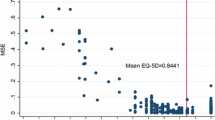Abstract
The aim of this study was to design an individualised questionnaire to measure the impact of macular disease (MD) on quality of life (QoL). Principles underlying the Schedule for the Evaluation of Individual Quality of Life (SEIQoL) interview method and the Audit of Diabetes-Dependent Quality of Life (ADDQoL) diabetes-specific questionnaire influenced the Macular Disease-Dependent Quality of Life (MacDQoL) design. The MacDQoL specifies domains of QoL that were selected using focus group methodology and refined following a postal pilot study of members of the UK Macular Disease Society (MDS). Respondents rated the impact of MD on each domain and the importance of each domain to their QoL. Mean domain scores from 69 respondents indicated that MD had a negative impact on all the domains of QoL investigated in the measure. There was preliminary evidence of good internal consistency reliability (Cronbach's α= 0.93, n = 37). Respondents who were registered partially sighted (P/S) or blind reported poorer QoL than those who were not registered (Kruskal–Wallis:χ 2= 14.03, n = 62, p < 0.001). This evidence suggests that the measure will be sensitive to subgroup differences. The instrument has been further refined following the pilot study. The MacDQoL is being used in clinical trials and psychometric evaluation of the measure will be carried out using trial data. The measure is available for clinical use and has been linguistically validated in 15 other languages.
Similar content being viewed by others
References
O'Shea JG. Age-related macular degeneration. Postgrad Med J 1988; 74: 203-207.
Bowling A. Measuring Health. Buckingham, UK: Open University Press, 1997.
Gill TM, Feinstein AR. A critical appraisal of quality of life measurements. JAMA 1994; 272: 619-626.
Bradley C. Importance of differentiating health status from quality of life. Lancet 2001; 357: 7-8.
Mangione CM, Lee PP, Pitts J, et al. Psychometric properties of the National Eye Institute Visual Function Questionnaire (NEIVFQ). Arch Ophthalmol 1998; 116: 1496-1504.
Joyce CRB. Requirements for the assessment of individual quality of life. In: McGee H, Bradley C (eds), Quality of Life Following Renal Failure. Chur, Switzerland: Harwood Academic Publishers, 1994.
Ellwein LB, Fletcher A, Negrel AD, Thulasiraj RD. Quality of life assessment in blindness prevention interventions. Int Ophthalmol 1995; 18: 263-268.
Scott IU, Schein OD, West S, et al. Functional status and quality of life measurement among ophthalmic patients. Arch Ophthalmol 1994; 112: 329-335.
Mangione CM, Gutierrez PR, Lowe G, et al. Influence of age-related maculopathy on visual functioning and health-related quality of life. Am J Ophthalmol 1999; 128: 45-53.
Williams RA, Brody BL, Thomas RG, et al. The psychosocial impact of macular degeneration. Arch Ophthalmol 1988; 116: 514-520.
Hazel CA, Petre KL, Armstrong RA, et al. Visual function and subjective quality of life compared in subjects with acquired macular disease. IOVS 2000; 41(6): 1309-1315.
Childs A. Responsiveness of the SF-36 health status survey to changes in vision. Qual Life Res 2002; 11(9): 657 [Abstract].
McGee HM, O'Boyle CA, Hickey A, et al. Assessing the quality of life of the individual: The SEIQoL with a healthy and with a gastroenterology unit population. Psychol Med 1991; 21: 749-759.
Ruta DA, Garratt AM, Russell IT. Patient centred assessment of quality of life for patients with four common conditions. Qual Health Care 1999; 8(1): 22-29.
Stewart TJ. A critical survey on the status of multiple criteria decision making theory and practice. OMEGA Int J Mgmt Sci 1992; 20(5/6): 569-586.
Bradley C, Todd C, Gorton T, et al. The development of an individualised questionnaire measure of perceived impact of diabetes on quality of life: The ADDQoL. Qual Life Res 1999; 8: 79-91.
Bradley C, Speight J. Patients' perceptions of diabetes and diabetes therapy: Assessing quality of life. Diabetes Metab Res Rev 18(3): 964-969.
Woodcock AJ, Julious SA, Kinmonth AL, Campbell MJ. Problems with the performance of the SF-36 among people with type 2 diabetes in general practice. Qual Life Res 2001; 10: 661-670.
Kinmonth AL, Woodcock A, Griffin S, et al. Randomised control trial of patient centred care of diabetes in general practice: Impact on current well-being and future disease risk. BMJ 1998; 317: 1202-1208.
DAFNE Study Group. Training in flexible, intensive insulin management to enable dietary freedom in people with type 1 diabetes: Dose adjustment for normal eating (DAFNE) randomised controlled trial. BMJ October 2002. http://bmj.com/cgi/content/full/325/7367/746.
Bradley C. Design of a renal-dependent individualized quality of life questionnaire. Adv Perit Dial 1997; 13: 116-120.
McMillan CV, Bradley C, Gibney J, et al. A comparison of the psychometric properties of quality of life and related measures (GWBI, W-BQ12, NHP, SF-36 and HDQoL) for use in research in adult growth hormone deficiency (GHD). Qual Life Res 2000; 9: 324, Abstract.
Mitchell J, Bradley P, Anderson SJ, et al. Perceived quality of health care in macular disease: A survey of members of the Macular Disease Society. Br J Ophthalmol 2002; 86: 777-781.
Nunnally JC, Bernstein IH. Psychometric Theory. 3rd ed. New York: McGraw Hill, 1994.
Nobre FF, Trotta LTF, Gomes LFAM. Multi-criteria decision making-An approach to setting priorities in health care. Stat Med 1999; 18: 3345-3354.
Trauer T, Mackinnon A. Why are we weighting? The role of importance ratings in quality of life measurement. Qual Life Res 2001; 10: 579-585.
Woodcock A, Bradley C, Plowright R, Hirsch A. How does diabetic retinopathy affect quality of life? Interviews to guide the design of a condition-specific, individualised questionnaire: The RetDQoL. Diabetic Med 2002; 19(Suppl 2): 98-99.
Todd C, Bradley C. Evaluating the design and development of psychological scales. In: Bradley C (ed), Handbook of Psychology and Diabetes: A Guide to Psychological Measurement in Diabetes Research and Practice. Chur, Switzerland: Harwood Academic Publishers, 1984.
Author information
Authors and Affiliations
Rights and permissions
About this article
Cite this article
Mitchell, J., Bradley, C. Design of an Individualised Measure of the Impact of Macular Disease on Quality of Life (the MacDQoL). Qual Life Res 13, 1163–1175 (2004). https://doi.org/10.1023/B:QURE.0000031348.51292.4a
Issue Date:
DOI: https://doi.org/10.1023/B:QURE.0000031348.51292.4a



